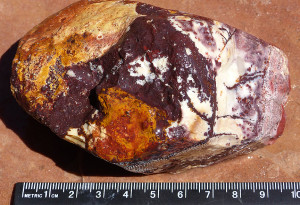OF SOUTHWEST NEW MEXICO
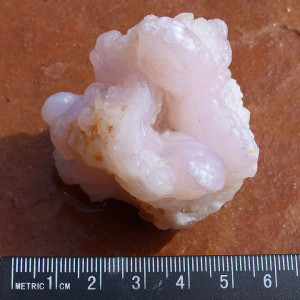
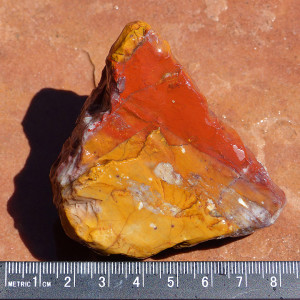
CHALCEDONY AND JASPER: QUARTZ GEMSTONES OF UNIQUE FORM AND COLOR
Chalcedony and Jasper are two distinct gemstone varieties of the diverse quartz mineral family that occur abundantly throughout the Gila Country of Southwest New Mexico. Both of these gemstones are composed of cryptocrystalline quartz, meaning that they consist of a tightly-bound aggregate of tiny crystals of quartz, SiO2, so small that it requires a polarizing or electron microscope to resolve the individual crystals. While chalcedony and jasper are commonly found together in areas where volcanic activity has been extensive, they differ markedly in appearance and their origins involve somewhat different processes.
CHALCEDONY
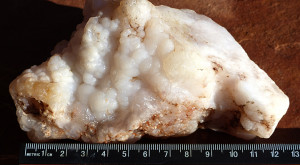
Chalcedony is best described as a dense, semitransparent or translucent variety of SiO2 consisting of a cryptocrystalline intergrowth of mostly quartz and lesser amounts of moganite, another form of SiO2 that has a different crystal form. Chalcedony breaks with a conchoidal fracture and commonly displays a waxy, vitreous, or silky luster. In terms of color it is most commonly white to gray, sometimes displaying a blue or pink tint due to mineral impurities or an optical phenomena known as Rayleigh Scattering. (Chalcedony by definition does not show distinct layers of color banding; if color banding is present then the specimen is called “agate”.) It has a hardness of 6 to 7 on the Moh’s Scale and a Specific Gravity of 2.6. In the Gila County, chalcedony can assume a wide range of unique and interesting shapes and forms, depending on how, where, and when it formed in the volcanic host rock.
In general, chalcedony forms by filling cavities in rocks. Such cavities may form as gas bubbles in a lava flow; irregular vugs or open space within a solid rock; or horizontal cavities along bedding planes, that result from solution of the preexisting rock, faulting or movement within the rock, or other geologic processes. Geodes, for example, form from the partial filling of gas bubbles in this manner, often consisting of layers of chalcedony which only partially fill the void which is then lined with macro-crystals of quartz. In other cases, the chalcedony (or if it shows banding, agate) will completely fill the cavity, resulting in what is known to rockhounds as “thunder eggs”.
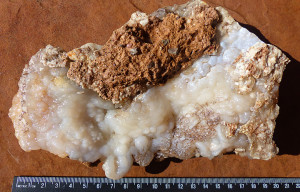
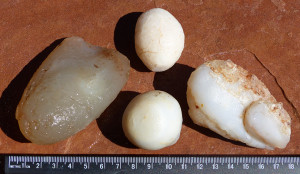
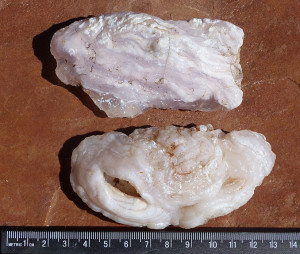

Given an open space or cavity within a rock, chalcedony forms when subsequent silica-rich watery fluids or viscous silica gels enter or are injected into the cavity. This process occurs as a result of hydrothermal circulation at low temperatures and pressures, from which the chalcedony is either deposited in molecular thin layers that slowly over time either partially or completely fill the cavity, or all at once in the form of a viscous gel. Commonly, the surface of the chalcedony deposited within a partially-filled cavity will display a smooth, but lumpy, surface known as a botryoidal texture or habit, resembling a bunch of grapes. Another common occurrence is that of the surface of the chalcedony filling being covered with small quartz crystals, known as druzy quartz.
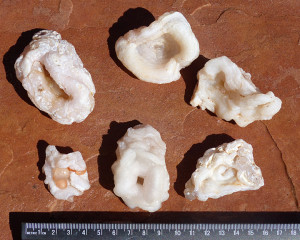
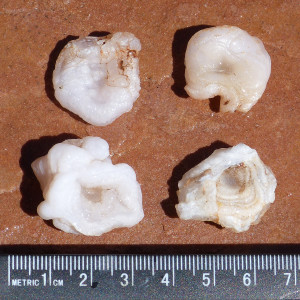
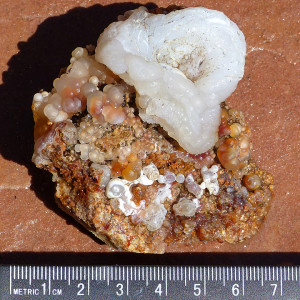
A unique and highly sought after form of chalcedony that is commonly found within the Gila Country is a type known as “Chalcedony Roses”(see excellent photos towards the bottom of the linked page). These unusual specimens consist of flower-like growths that formed when a hot silica gel of chalcedony composition, having a viscosity perhaps similar to that of toothpaste, was injected under pressure into the open cavity. No two roses are alike in size and form, making them highly collectible.


However, for most discriminating and serious collectors, the most precious form of chalcedony that can be found in the Gila Country and neighboring Southeast Arizona is a form known as “Fire Agate”. Fire Agate is generally not considered a true agate as it does not display the typical color banding of agate. Rather, this interesting form of chalcedony consists of inclusions of molecular-thin layers of iron III oxide minerals Goethite FeO(OH) and Limonite (FeO(OH).nH2O. crystals which are deposited on the botryoidal surface of colorless, translucent to transparent chalcedony. The Goethite and Limonite layers are in turn then subsequently covered over by additional thin layers of colorless chalcedony. When this sequential process is repeated several times it produces a gemstone, that when properly cut and polished gives a vivid, brilliant and complex play of various colors of yellow, orange, red, brown, green, purple, and sometimes blue. The cutting and polishing of fire agate is a fine art, requiring considerable experience to preserve and display the desired play of colors and not grind and polish the thin, delicate layers of color away.

WHERE TO FIND CHALCEDONY IN THE GILA COUNTRY …
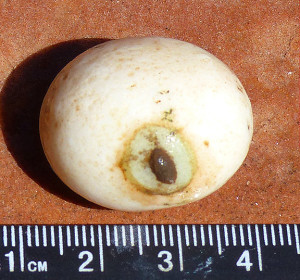
The short answer is almost everywhere. The dominant geology of the Gila Country of Grant and Catron Counties is that of volcanic rock deposited between 34 and 15 million years ago. An earlier blog on this site, the Super-Volcanoes of the Gila Wilderness, gives a brief history of the major volcanic events that occurred here. Compositionally, the volcanic rocks of the Gila range from silica-rich rhyolites to silica-deficient basalts; however, in terms of absolute volume the silica rich rhyolites are by far the dominant rock type.
Throughout Grant and Catron Counties are vast areas of uplifted mountain masses of these silica-rich volcanic rocks. The Gila National Forest alone, for example, encompasses some 3.3 million acres consisting primarily of such terrain. Surrounding these uplifted volcanic masses are adjacent, down-dropped trenches and basins that are filled with volcanic sedimentary rock debris that has been weathered, eroded, and subsequently carried by streams and rivers flowing out of the uplifted mountains. These sedimentary deposits range from older (5-10 million years), tightly-cemented sandstone conglomerates and sandstones, such as the widespread and ubiquitous Gila Conglomerate Formation, to more recent deposits, such as are currently being carried downstream in modern floodplains.
Almost all of these rocks and sediments are likely to contain collectible specimens of chalcedony. Of course, some areas are better than others … and that’s where experience and the thrill of the hunt begins! While there are areas where collectible chalcedony can be discovered and extracted (generally with great expenditure of energy) from the matrix of solid volcanic host rock, such as around the tailings dumps of old mines, most experienced collectors will instead choose to let nature do the hard work, and hunt for specimens in the shallow, unconsolidated, weathered surface deposits covering the unweathered volcanic rock bedrock. For the less-than-determined collector the best method, and quite often the method that yields the greatest return both in terms of number and quality of specimens found, involves extensive walking across the surface of the vast areas of sedimentary deposits surrounding the uplifted mountain masses. The reason for this is that chalcedony has a hardness of 6 to 7 and is highly resistant to both chemical and physical weathering, whereas the host matrix volcanic rock consists of a high percentage of minerals that are both softer and more-readily broken down through weathering and erosion. Hence, over time, the chalcedony remains unaltered, is totally freed from the matrix rock, and is concentrated in the sedimentary deposits. Collecting chalcedony in this manner is thus a walker’s or hiker’s delight, where success is proportional to the area covered.
JASPER
Jasper was used extensively by stone age cultures in the making of projectile points and other tools, and has been prized as a gemstone for thousands of years. Today, it is a highly sought after gemstone material that is mined from diverse deposits worldwide, and marketed under a variety of descriptive names depending upon the color and patterns displayed by the polished stone, such as “picture jasper”, “poppy jasper”, “ocean jasper”, “bloodstone”, etc.
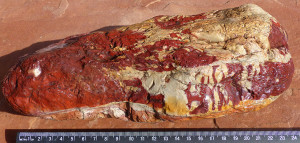
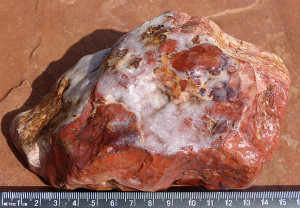
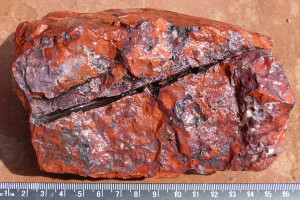
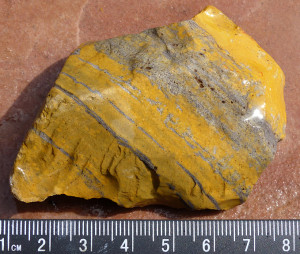
Jasper is a cryptocrystalline variety of quartz but, unlike chalcedony, is opaque due to the high content of mineral impurities, most commonly iron III oxide minerals such as Hematite (Fe2O3), Goethite (FeO(OH), and Limonite (FeO(OH).nH2O. The color of most of the jasper found in the Gila Country ranges from a deep purplish red to blood red to shades of yellow, orange, brown, and occasionally green. These colors can either present as a single solid color or several different colors that either grade from one to the other or are intermingled in complex patterns. The best quality jasper in terms of usefulness as a gemstone, are specimens that have a dense, homogeneous internal structure, break with a conchoidal fracture, and have a waxy or vitreous luster similar to chalcedony. Such material has a hardness of 6 to 7 on the Moh’s Scale and a Specific Gravity of 2.5 to 2.9 because of the high iron content.
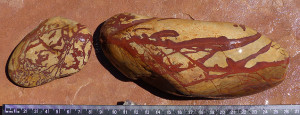
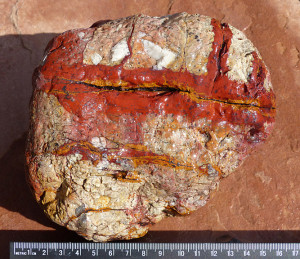
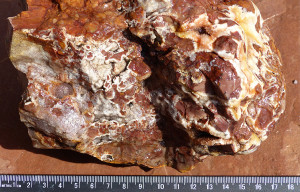
Jasper most commonly occurs in veins, or as fillings in cracks and fractures in volcanic rocks where it has been later injected and deposited from hot, silica-rich aqueous solutions percolating through the rock. Sometimes jasper is deposited in fault zones where there have been repeated injections and precipitation from iron-rich silica bearing solutions which have been subsequently broken up by repeated faulting and internal crushing, and then re-cemented by further jasper deposition. Such deposits are called jasper breccias. Jasper breccias can be quite distinctive and striking, displaying a complex assemblage of jasper fragments of diverse color, sometimes along with fragments of chalcedony and macro-crystalline quartz, and are thus highly sought after for use as a gemstone.
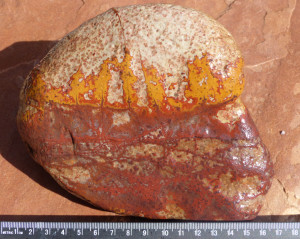
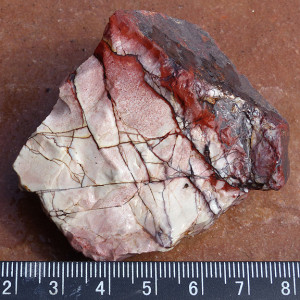
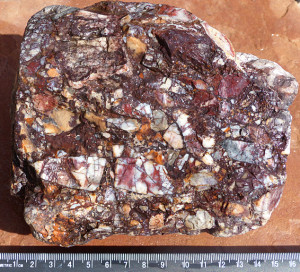
WHERE TO FIND JASPER IN THE GILA COUNTRY …
Jasper is often found in all of the same places where chalcedony occurs. Since it forms in veins and rock fractures, where it is discovered in solid rock outcrops it can be hand quarried with modest effort using a hammer and chisel. Such veins are not common, but can be found in areas of old mines and prospects. However, for the novice collector or person unfamiliar with the area and known localities, as was suggested for collecting chalcedony, the best (and easiest) approach is to walk the surfaces of modern sedimentary deposits which have been transported out of nearby volcanic mountains such as along river and creek floodplains, and dry washes, or to explore areas where there are exposed surfaces of weathered and eroded Gila Conglomerate.
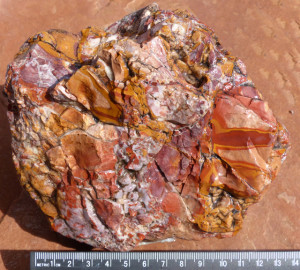
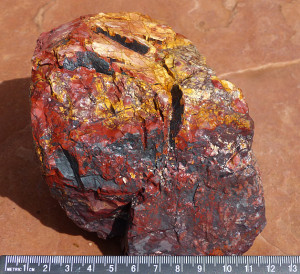
ROCKHOUNDING AND GEM AND MINERAL COLLECTING
USING CASITAS DE GILA GUESTHOUSES AS YOUR BASE
Within day-trip driving range of the Casitas de Gila Guesthouses there are unlimited locations where chalcedony, jasper, and other semi-precious gemstones, diverse minerals, and just plain interesting rocks can be searched for on the public lands of the Gila National Forest or Bureau of Land Management. Some of these areas are officially designated tracts of public land set aside specifically for rockhounding (i.e., Rockhound State Park, Black Hills Rockhound Area, and Round Mountain Rockhound Area). Casitas de Gila Guesthouses is familiar with many of these areas and will be pleased to provide maps, directions, and local information to our guests.
Guests staying at Casitas de Gila Guesthouses are, of course, also most welcome to search for chalcedony, jasper, and other minerals and interesting rocks on the Casita lands. Except for around our home … where we place the rocks we have collected!

